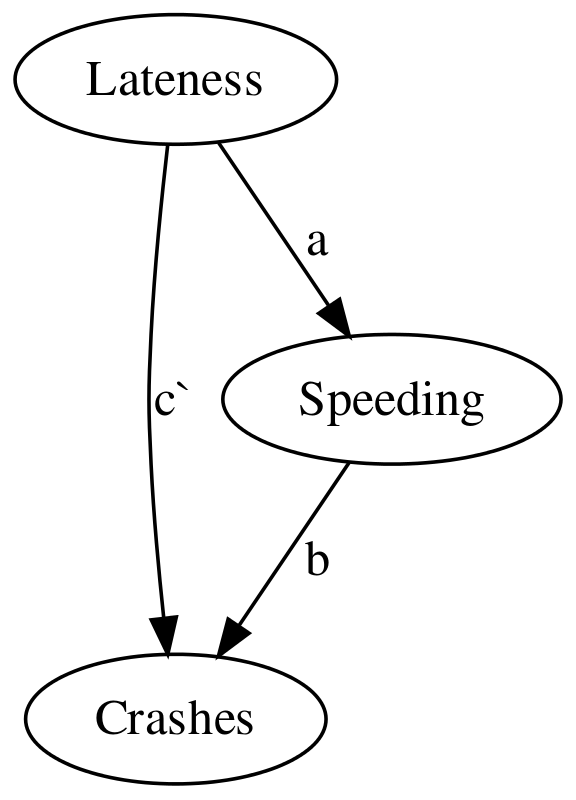Testing the indirect effect
Baron and Kenny also introduced conventions for labelling some of the coefficients from the regressions described above.
Specifically, the described a as the path from the predictor to the mediator,
b as the path from the mediator to the outcome, and c' (c prime) as the
path from predictor to outcome, controlling for the mediator. As shown here:
knit_gv("
Lateness -> Crashes[label='c`']
Lateness -> Speeding[label=a]
Speeding -> Crashes[label=b]
")
Subsequent authors wished to provide a test for whether the path through a and
b — the indirect effect — was statistically significant.
@preacher_spss_2004 published SPSS macros for computing this indirect effect and
providing a non-parametric (bootstrapped) test of this term. The same approach
is now implemented in a number of R packages.
The mediation::mediate function accepts the 2nd and 3rd regression models from
the ‘Baron and Kenny’ steps, along with arguments which identify which variables
are the predictor and the mediator. From this, the function calculates the
indirect effect, and the proportion of the total effect mediated. This is
accompanied by a bootstrapped standard-error, and asociated p value.
For example, using the models we ran above, we can say:
set.seed(1234)
crashes.mediation <- mediation::mediate(step2, step3, treat = "lateness", mediator = "speed")
summary(crashes.mediation)
Causal Mediation Analysis
Quasi-Bayesian Confidence Intervals
Estimate 95% CI Lower 95% CI Upper p-value
ACME 0.1477 0.0237 0.28 0.018 *
ADE 0.2998 0.1166 0.50 <2e-16 ***
Total Effect 0.4475 0.2293 0.66 <2e-16 ***
Prop. Mediated 0.3295 0.0741 0.60 0.018 *
---
Signif. codes: 0 '***' 0.001 '**' 0.01 '*' 0.05 '.' 0.1 ' ' 1
Sample Size Used: 200
Simulations: 1000 From this output, we can see that the indirect effect is statistically significant, and that around hald of the total effect is mediated via speed. Because lateness in iteself is not a plausable cause of a crash, this suggest that other factors (perhaps distraction, inattention) might be important in mediating this residual direct effect.